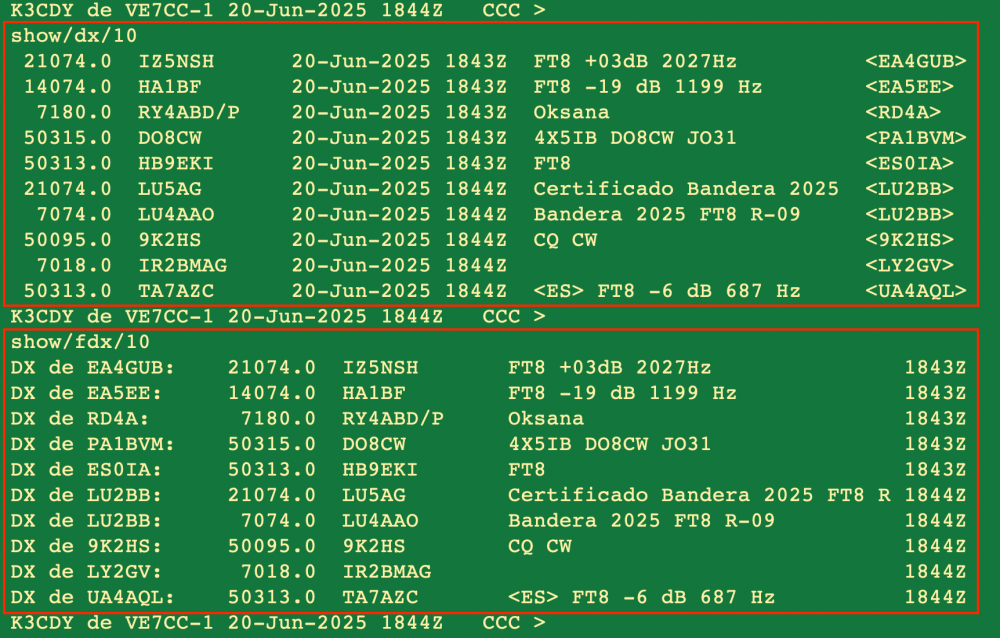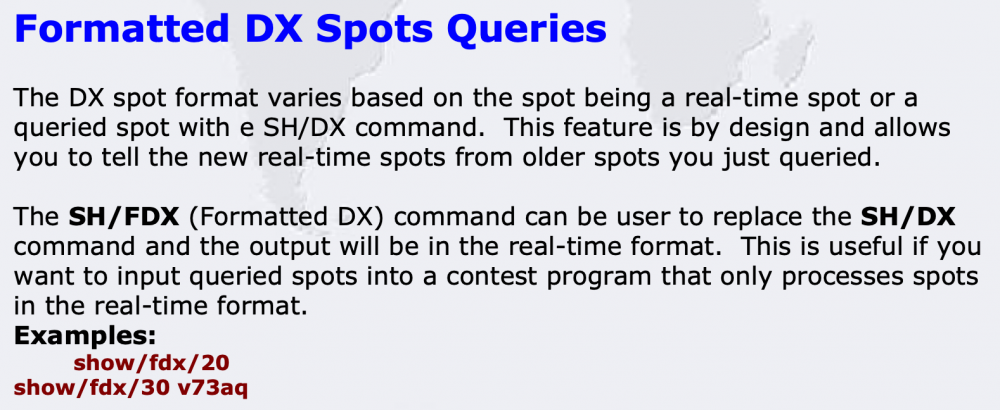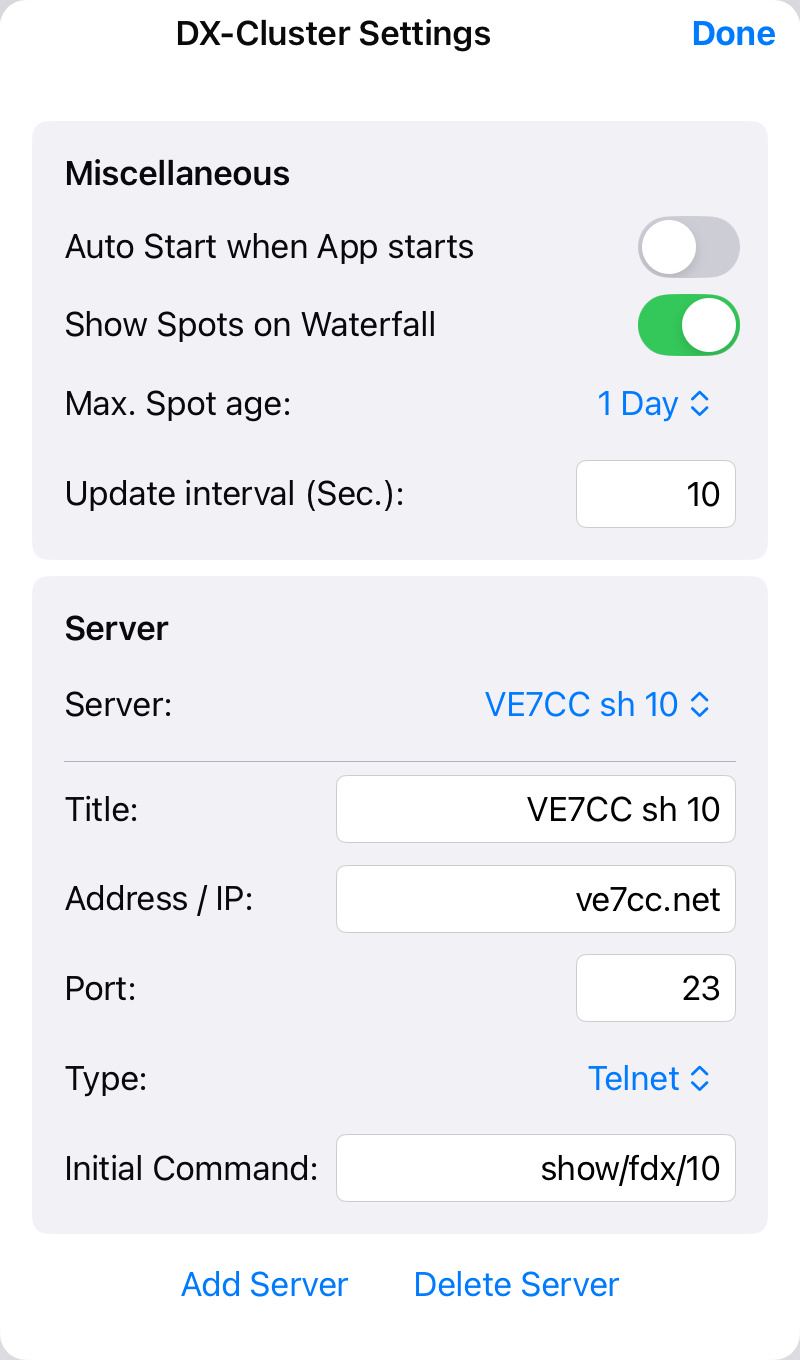SmartSDR v4.1.3 and the SmartSDR v4.1.3 Release Notes
SmartSDR v3.10.15 and the SmartSDR v3.10.15 Release Notes
The latest 4O3A Genius Product Software and Firmware
Need technical support from FlexRadio? It's as simple as Creating a HelpDesk ticket.
How to Initially Populate Spots in Mac SmartSDR?
Folks, I am stumped. When I first open Mac SmartSDR and connect to a DXcluster for spots, I like to collect some spots to populate my panadapter rather than wait for them to trickle in. In a cluster app, I would use a command like "sh/dx/100" to grab the last 100 spots. I have tried and tried to figure out how to do this in Mac SmartSDR unsuccessfully. What is the trick to this? Has anyone done this? This would generally be with an AR-Cluster server.
73, Steve AK0M
Comments
-
Hi Steve
yes....you can .... you need to create a new cluster server
i use VE7CC a lot so created a VE7CC ( Show 10)
you can see in the initial Command line i added teh command show/dx/10/
need to knw the exact command for cluster tye you are using
Paul K3SF
0 -
Paul, thanks, the screen shot was really helpful. But that is exactly the setup I have (other than call) and it doesn't work for me. I get spots, but only new ones. I have never been able to get anything in the Initial Command field to produce results. Although it works fine if I connect directly to the cluster through any of my other programs. I have also tried on several Macs, a couple different iPads, and my iPhone... none seem to work. It IS tricky to figure out what Type each telnet server is though.... I still don't have a good understanding of how to do that.
73, Steve
0 -
Does anyone have this working?
I would expect that adding "sh/dx/100" into the Initial Command box, then clicking Start, would fill my pan adaptor with the last 100 spots immediately. I see none, only new ones as they trickle in.
Steve AK0M
0 -
Depending on the cluster I think you can do a 'sh/fdx/100' and it send the older spots formatted differently.
Michael, AA5SH
0 -
Does anyone have this working? I am still unsuccessful. Using the same command strings that work fine through a direct telnet connection, but they don't work from within the DX Cluster feature.
To summarize, when I start the DX Cluster feature, I want it to download the last 100 spots in order to populate the panadaptor with recent spots.
Steve AK0M
0 -
I have never been able to get this to work.
Now in the latest version, there is no option even for my call to log in to the server.
Has ANYONE found a way to populate the spots initially?? Or do we just have to wait for them to trickle in?Or is there a way to connect to a different app for the spots?
0 -
Hi Steve - I'm using Mac SmartSDR, and I tried using "show/dx/100" as the initial command for ve7cc.net, and it didn't work. I also use MacLoggerDX, and tried using similar commands in that app, and past spots appear immediately. I also did a manual Telnet session to ve7cc.net in the Terminal app, and show/dx/100 worked immediately.
This is a bug in Mac SmartSDR's DX Cluster tool. I've discovered and reported other DX Cluster bugs, so there's clearly some room for improvement.
Marcus is pretty good about addressing issues that I've reported, so let's both send him a bug report. (Use the Help / Contact Support… function built into the app).
0 -
Thanks for checking, Bill. I submitted this request over a year ago. But just sent another.
73,
Steve AK0M
0 -
Sounds good Steve. I sent my bug report yesterday.
0 -
I wonder what the deficiency is? I have spots working for SSDR for Mac. I just set Spots On in radio configuration, bring up DXCluster tool and Boom, all is working. I can select different Cluster telnet sources, filter spots using different criterias, etc. What function am I missing? Dan WA1QZX
-1 -
Hi Dan -
Admittedly, I had to re-read Steve's post a couple times to understand the deficiency. In short, some folks will simply connect to a DX cluster server, not issue any special server commands, and just wait for the spots to slowly appear in real time.
Steve (and I) would like to take advantage of a DX cluster server's ability to provide recent HISTORICAL spots, perhaps the last 10 or 50, to get a sense of where the action is. If MacSSDR were working correctly, the optional "initial command" in the cluster's settings, of perhaps, "show/dx/100" would IMMEDIATELY blast 100 spots to the screen (and map). This doesn't work in MacSSDR.
On my Mac, using a manual telnet session (in the Terminal app) connected to ve7cc.net, port 23, here's what the cluster server sends after I issue a "show/dx/10" command:
In MacSSDR, I have the VE7CC cluster configured as follows:
If MacSSDR were working correctly, I'd see those 10 spots immediately populate the DX Cluster window and waterfall as soon as I make the connection to VE7CC. Instead, spots just slowly trickle in, in real time.
0 -
Hi Bill,
Just to confirm that I am also seeing the same problem with SmartSDR for MacOS. I setup a cluster connection with the initial command configured as per your example and ran Wireshark to capture the exchange between MacOS SmartSDR and the cluster. In the wireshark log I can see that SmartSDR does send the sh/dx/10 command and the 10 spots are sent back to SmartSDR but they are not displayed in the cluster tool. So its definitely a MacOS SmartSDR bug. I'm sure Marcus will respond to yoru bug report.
73,
Jonathan G4IVV0 -
That was a great idea Johnathan. Thank you for further confirming the issue.
0 -
Thanks for clarifications!
0 -
I got a response from Marcus today, who explained the issue, which turns out to be no issue at all.
The initial cluster command "show/dx/10" will respond with the last 10 spots, UNFORMATTED. MacSSDR's DX Cluster tool does not recognize unformatted spots from a cluster server. However, if you use "show/fdx/10" (note the "f" prefix), the cluster server will report the last 10 spots FORMATTED the same as a real-time spot. This makes MacSSDR happy, and the last 10 spots are displayed within a few seconds of starting the DX Cluster tool.
Here's an example of the differences between the show/dx/10 and show/fdx/10 in a telnet terminal session to ve7cc.net (port 23):
I tried this on other cluster servers, and not all recognize the "fdx" command, so YMMV.
I found an AR-Cluster user manual online HERE that gives a pretty good explanation. Here's the relevant section of the manual:
Chalk this one up to the nuances of clusters! (Steve, I think you can safely mark this problem "solved"!)
0 -
”show/fdx/10” does not work for me. I just get a response from the app “Receiving” then it times out.
Also, seems odd there is no place for me to enter my call like in the old settings screen.
Bill, did you actually try it in iOS SmartSDR?
Steve AK0M0 -
Hi Steve -
I tried SmartSDR on my iPad, and it worked fine, using precisely the settings you show above. Nothing appears to happen at first, but then the initial 10 spots appear after 20-30 seconds.
I don’t use the iOS version however, so perhaps there’s a bug with that one.
0 -
Bill, I am trying this on my iPad. That is the iOS version. I see spots show after 20-30 seconds but they are just the real time spots trickling in. I am not seeing any of the history. It’s really obvious if you try a sh/fdx/50 or 100… just the real time spots trickle in. Haven’t tried it on my Mac yet, maybe the sh/fdx works on that version?
Steve0 -
Hi Steve -
I just tried it again on my iPad, and it worked fine. Below are my settings for a 30-spot history. Make sure you have filters turned off. Also, I noticed the app was just updated to 7.0.72, so maybe that made a difference. For my 50-spot formatted download, it took about 20 seconds to appear and they all appeared at once. Also, when I first tried it, it didn’t work, but then it started to function reliably after hitting the trash icon, then re-starting the spotter. I changed the number of spots ranging from 10 to 50, and everything is working.
Hope this helps!
0 -
Hi Bill,
My settings were just like yours. But it works tonight! Maybe a version change did something? I did have my filters on and it worked fine.
Thanks for your help!
73, Steve
1 -
Well, it was a full moon…
Glad to hear!
0
Categories
- All Categories
- 372 Community Topics
- 2.1K New Ideas
- 629 The Flea Market
- 8.2K Software
- 94 SmartSDR+
- 6.4K SmartSDR for Windows
- 183 SmartSDR for Maestro and M models
- 424 SmartSDR for Mac
- 270 SmartSDR for iOS
- 255 SmartSDR CAT
- 190 DAX
- 381 SmartSDR API
- 9.3K Radios and Accessories
- 36 Aurora
- 249 FLEX-8000 Signature Series
- 7.2K FLEX-6000 Signature Series
- 937 Maestro
- 54 FlexControl
- 863 FLEX Series (Legacy) Radios
- 917 Genius Products
- 460 Power Genius XL Amplifier
- 334 Tuner Genius XL
- 123 Antenna Genius
- 294 Shack Infrastructure
- 206 Networking
- 452 Remote Operation (SmartLink)
- 144 Contesting
- 782 Peripherals & Station Integration
- 139 Amateur Radio Interests
- 997 Third-Party Software







